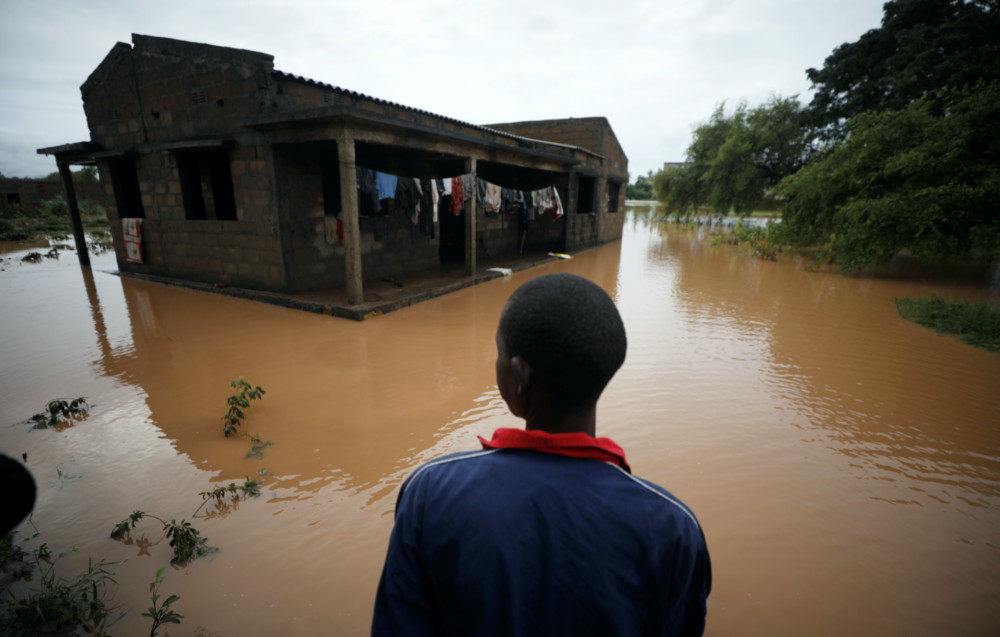From Louisiana’s battle with two hurricanes and an icy polar vortex in the past year to Kenya’s struggle with locusts, drought and floods, climate risks are piling up – and colliding with other threats like COVID-19, making them harder to manage.
“By the time you start to recover from one direct hit, another one is coming,” said Erin Sikorsky, director of the International Military Council on Climate and Security.

Agiro Cavanda looks at his flooded home in the aftermath of Cyclone Kenneth, at Wimbe village in Pemba, Mozambique, on 29th April, 2019. PICTURE: Reuters/Mike Hutchings/File photo.
As leaders of countries on the UN Security Council meet Tuesday to talk about climate pressures and global peace, it is increasingly clear that rising temperatures will fuel instability, from conflict to displacement, she said.
The impacts of a heating planet, such as scarcer water in shared rivers and more failed harvests, can hike existing tensions between countries, said Sikorsky, who is also deputy director of the US-based Center for Climate and Security.
Getting the UN Security Council to act won’t be easy, she acknowledged, not least because some permanent members, including China and Russia, have been reluctant to frame climate change as a security threat.
But predicting where climate-driven security risks might flare up – perhaps by establishing global or regional “watch centres” – could help save lives, she said.
“We have good foresight capabilities about what’s coming down the pipe with climate change,” she said.
“If we can integrate that into our planning and warning systems, we can prepare for, and potentially prevent, some of the worst security outcomes,” she added.
Considering climate threats in all UN decision-making – as the United States under President Joe Biden aims to do across government departments – also could help, Sikorsky said.
“You have to make it part of regular business. If you don’t, you’re going to miss stuff,” she said.
As climate shocks and stresses – from sea level rise to more extreme weather – flare up around the world, Sikorsky highlighted some hot-spots:
1. South Asia
In a region with nuclear-armed nations, from India to China, shared rivers are drying, and continued dam-building to control their limited flow is sparking tensions over scarcer water.
As Himalayan glaciers melt and climate change brings more rainfall extremes, those tensions will exacerbate the “serious mistrust” already evident among countries, Sikorsky said.
That mistrust means governments lack joint communication systems to share information about river flows and other threats, which could help prevent disasters and provide avenues for cooperation.
2. The Mekong River
China and its downstream Mekong River neighbours disagree on how to manage declining water flows, rising seas and saltwater intrusion – and that failure to cooperate could spark food security concerns there and in rice-buying countries elsewhere.
A range of mechanisms to improve cooperation along the river have been proposed, but countries can’t agree on which to use.
Such sticking points are a worry as climate change increases the risk of staple food crops failing in different parts of the world at once, due to impacts like drought and extreme heat.
“The chances of it happening are higher now than they have been,” Sikorsky said.
That raises the possibility of limited food supplies not getting to places that need them most, as shortages lead to export bans.
3. East Africa
The last year has brought a wave of problems to the region, from floods and crop-munching locust plagues to COVID-19 and conflict in Ethiopia’s Tigray region between the former ruling party in the northern region and the federal government.
With extremist groups already operating in Somalia and parts of Kenya, the piling on of climate pressures means risks are growing in a “messy” part of the world in security terms.
4. Central America
Nicaragua was hit by one of its worst hurricanes ever last November. That and other storms, combined with worsening drought and extreme rainfall in the region, have slammed coffee harvests.
As incomes collapse, the climate-spurred crisis is pushing rural communities to migrate in search of new work opportunities, with some heading to North America.
5. The United States
The United States has not traditionally been considered a country highly vulnerable to climate change or its security implications.
But a mix of disastrous wildfires, flooding, storms and the unusual snow and freezing temperatures that have shut down power utilities in Texas this month raises questions about how prepared the geographically diverse nation is to respond.
Floridians may understand how to stay safe from floods or Californians how to evacuate from fires – but weak understanding countrywide of the overall rising level of threat “makes it hard to make national policy”, said Sikorsky.






